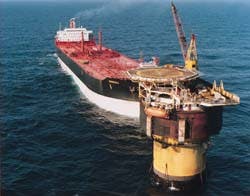Shell U.K. Exploration & Production (Expro) plans to dump its Brent field spar offshore loading buoy in Jeep water off Northwest Britain this year.
The U.K government and operations view the project as a test case for platform dumping.
Expro's best practicable environmental option study for abandonment of the spar considered six options: horizontal dismantling and onshore disposal, vertical dismantling and onshore disposal, infield disposal, deepwater disposal, refurbishment and reuse, and continued maintenance.
An earlier review showed refurbishment and continued maintenance to keep the spar operational would cost 90 million ($135 million) and require 2-3 years. Expro in September 1991 chose to shut down the spar.
SPAR STRUCTURE
Brent's spar is a 65,000 metric ton structure, with capacity to store 300,000 bbl of oil in six tanks. It is 141 m high and 29 m in diameter at its main chamber.
The unit began operation in the North Sea's Brent field in December 1976 and was decommissioned in August 1991. Typical throughout to tankers was about 200,000 b/d.
The spar allowed production from brent field before installation of an oil pipeline from the field to Sullom Voe terminal in Scotland. After the pipeline went on stream in november 1979, the buoy was retained as an alternative to pipeline export.
ABANDONMENT OPTIONS
Expro trimmed its abandonment options list to horizonal dismantling or deepwater disposal before carrying out a detailed feasibility study and cost estimate of the two methods.
Vertical dismantling was seen as having no advantage over horizontal dismantling but was rejected because of the need for an inshore deepwater dismantling site, which is not available around Britain.
In-field disposal was rejected as unacceptable compared with other options, even though it was the least expensive. Reuse was rejected because no one wanted to buy the spar. And continued maintenance was dismissed as too costly: an estimated 5.6 million/year ($7.5 million/year) and expected to increase with time.
Horizontal dismantling was estimated to cost 46 million ($69 million). The cost of deep-water disposal was pegged at 12 million ($18 million). No objections to deepwater disposal were raised by government, so Expro chose the cheaper option.
DISPOSAL
Expro has surveyed three disposal sites, the North Feni ridge, Rockall Trough, and Maury Channel in the Northeast Atlantic Ocean. The U.K. government is expected soon to choose among the three.
The spar will have explosives placed in its ballast thanks this summer, then it will be towed by tug to the disposal site and the charges detonated to sink it.
Expro says the structure is most likely to remain largely intact on the seabed and may then take as long as 4000 years to disintegrate. There is expected to be little leakage and environmental impact.
Copyright 1995 Oil & Gas Journal. All Rights Reserved.


